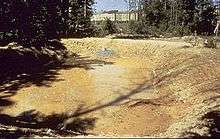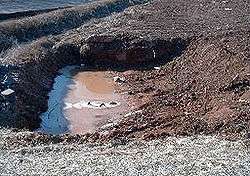Sediment basin

A sediment basin is a temporary pond built on a construction site to capture eroded or disturbed soil that is washed off during rain storms, and protect the water quality of a nearby stream, river, lake, or bay. The sediment-laden soil settles in the pond before the runoff is discharged. Sediment basins are typically used on construction sites of 5 acres (20,000 m2) or more, where there is sufficient room. They are often used in conjunction with erosion controls and other sediment control practices. On smaller construction sites, where a basin is not practical, sediment traps may be used.[1]
Essential sediment abundance is prevalent in the construction industry which gives insight to future endeavors. In essence lateral buckling occurs under traverse load or at critical loads.
On some construction projects, the sediment basin is cleaned out after the soil disturbance (earth-moving) phase of the project, and modified to function as a permanent stormwater management system for the completed site, either as a detention basin or a retention basin.[2]
Sediment trap

A sediment trap is a temporary device installed on a construction site to capture eroded or disturbed soil that is washed off during rain storms, and protect the water quality of a nearby stream, river, lake, or bay. The trap is basically an embankment built along a waterway or low-lying area on the site. They are typically installed at the perimeter of a site and above storm drain inlets, to keep sediment from entering the drainage system. Sediment traps are commonly used on small construction sites, where a sediment basin is not practical. Sediment basins are typically used on construction sites of 5 acres (20,000 m2) or more, where there is sufficient room.[3]
Sediment traps are installed before land disturbance (earth moving, grading) begins on a construction site. The traps are often used in conjunction with erosion controls and other sediment control practices.[4]
See also
References
- ↑ Florida Department of Environmental Protection. Tallahassee, FL. "Florida Erosion and Sediment Control Inspector's Manual: Temporary Sediment Basin." Section 4.26. Published 2002.
- ↑ California Stormwater Quality Association. Menlo Park, CA. "California Stormwater BMP Handbook: Sediment Basin." Fact Sheet No. SE-2. January 2003.
- ↑ California Stormwater Quality Association. Menlo Park, CA. "California Stormwater BMP Handbook: Sediment Trap." Fact Sheet No. SE-3. January 2003.
- ↑ Florida Department of Environmental Protection. Tallahassee, FL. "Florida Erosion and Sediment Control Inspector's Manual: Temporary Sediment Trap." Section 4.25. Published 2002.
External links
- Erosion Control - a trade magazine for the erosion control and construction industries
- International Erosion Control Association - Professional Association, Publications, Training
- "Developing Your Stormwater Pollution Prevention Plan: A Guide for Construction Sites." - U.S. EPA
